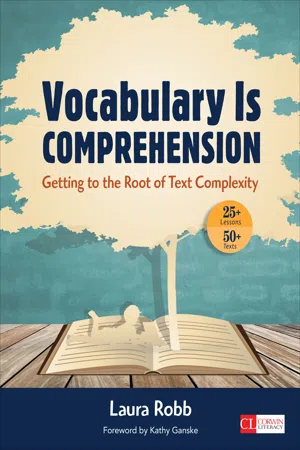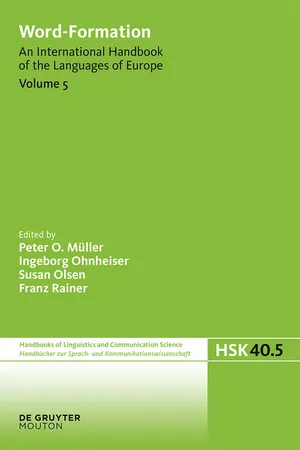Languages & Linguistics
Greek Roots, Suffixes and Prefixes
Greek roots, suffixes, and prefixes are fundamental elements in the formation of words in the English language. They are derived from the Greek language and are used to create new words or modify the meaning of existing words. Understanding these components can help in deciphering the meanings of unfamiliar words and expanding one's vocabulary.
Written by Perlego with AI-assistance
Related key terms
Related key terms
1 of 4
Related key terms
1 of 3
5 Key excerpts on "Greek Roots, Suffixes and Prefixes"
- eBook - ePub
Vocabulary Is Comprehension
Getting to the Root of Text Complexity
- Laura J. Robb(Author)
- 2014(Publication Date)
- Corwin(Publisher)
, suffixes, and roots to decode compound and multisyllable words.What the Common Core State Standards Have to Say
The Common Core Vocabulary Standard 4b states, “Use common, grade-appropriate Greek or Latin affixes and roots as clues to the meaning of a word.” Studying roots and affixes across the curriculum is an efficient way to enlarge students’ vocabulary. The study of one root along with prefixes and suffixes can lead to an understanding of 10 or more words related to that root.In Standard 6, the Common Core requires that students “acquire and use accurately grade-appropriate general academic and domain-specific words and phrases.” By building words using Greek and Latin roots, prefixes, and suffixes, students can improve their comprehension of academic vocabulary and develop fluency with 90 percent of the words that appear in texts for Grades 3 to 9 (Blachowicz, Fisher, Ogle, & Watts-Taffe, 2006; Berne & Blachowicz, 2009; Kieffer & Lesaux, 2007; Rasinski, Padak, & Newton, 2008).Ultimately, improved general academic and domain-specific vocabulary leads to students’ ability to read and comprehend grade-level complex texts. The most effective way to teach vocabulary is to select and teach roots that relate to topics in English, social studies, science, and mathematics. In this chapter, I show you how to go about this word study systematically, with the 10- to 15-minutes-a-day approach outlined in previous chapters.Definitions to Share With Students
Prefix: A prefix is a letter or a small group of letters that have meaning and are attached to the beginning of a word. Prefixes change the meaning of a root or a base word. For example, connect is a base word that means to join; add the prefix dis—disconnect - eBook - ePub
Activities for Successful Spelling
The Essential Guide
- Philomena Ott(Author)
- 2012(Publication Date)
- Routledge(Publisher)
Understanding and recall of keywords are significant factors for successful work on syllables. They can be established by using different strategies and a variety of tactics depending on preferred learning style. Many dyslexic learners have difficulties with word retrieval and word naming, so it is essential that teacher/learning partner and learner constantly revise and rehearse keywords, such as short and long vowel, consonant, blend, digraph, affix, root word, prefix, suffix and antonym. The teacher/learning partner and learner can discuss the aim of each activity, then review the list of keywords and look at the given examples. Further examples may be generated and these can be written on the board, on an overhead transparency (OHT) or on an interactive whiteboard to provide a computer printout. This can be filed in a personal ‘Spellofax’ for review and revision. Dictionary work will also play an important role as learners study meanings, derivations and the use of words.Aim: To identify, understand and use words with Latin rootsChecklist of useful Latin root words Word list based on The National Literacy Strategy Key Stage 2 Spellingbank (DfEE, 1999) The examples were chosen to show the use of both prefixes and suffixes, rather than listing every possibility.Keywords to review: A root word is the main part or stem of a word. It can take a prefix or suffix:
First, you need the checklist of useful Latin root words in front of youport er report er deport ed - look at each word
- say the word
- learn its meaning
- read the examples
- highlight the root word within each example
Using Latin root wordsChecklist of useful Greek root words Word list based on The National Strategy Key Stage 2 Spellingbank (DfEE 1999) The examples were chosen to show the use of both prefixes and suffixes, rather than listing every possibility.- look at each word
- say the word
- highlight the root and say its meaning (you can use a dictionary)
- copy out the word
- use it in a sentence
- use the proof-reading C-O-P-S
ACTIVITY Aim:To identify, understand and use words with Greek rootsKeywords to review: A root word is the main part or stem of a word. It can take a prefix or suffix:Using Greek root words
First, you need the checklist of useful Greek root words in front of youport er report er deport ed - Look at each word
- Say the word
- Highlight the root word say its meaning (you can use a dictionary)
- Copy out the word
- Use it in a sentence
- use the proof-reading C-O-P-S
Section A- have the checklists of Latin and Greek roots in front of you
- fill in the missing letters (below) to complete the word
- then make a sentence for each word
Section B – Quiz 1 Complete the quiz by using words from the Latin and Greek root checklists1. The name of an American political party. At one time Bill Clinton was one of the best known members of the . . . . . . . . . . . . . . . . . . party. - eBook - ePub
Indo-European Language and Culture
An Introduction
- Benjamin W. Fortson(Author)
- 2011(Publication Date)
- Wiley-Blackwell(Publisher)
4 Proto-Indo-European Morphology: Introduction The Root and Indo-European Morphophonemics4.1. Morphology is the study of the rules governing word-formation and inflection; the term also refers to the set of rules themselves in a given language. Words consist of one or more morphemes , the smallest meaningful units in a language. Morphemes can be whole words (e.g. Eng. bed , succotash , sarsaparilla ) or parts of words such as affixes (e.g. the Eng. prefix un- and suffix -ed ). In many languages, some morphemes can appear in different forms called allomorphs depending on their phonetic or morphological context (e.g. the Eng. prefix in- ‘not’ can appear as in- , im- , il- , ir- , as in in-credible , im-perfect , il-logical , ir-replaceable ). The morphophonemics of a language is the set of rules determining the distribution of allomorphs.A root is a morpheme from which semantically related words can be derived. The root itself does not usually exist as an independent form, but carries the semantic core of any word derived from it. In English, for example, the words commit , emit , transmit , remission , and missive are all derived from a root mit (borrowed from Latin) that conveys the basic meaning ‘send’. When reconstructing the vocabulary of PIE, typically it is roots that are reconstructed in the first instance (see below, 4.11, for more on this). Since they did not stand alone, they are conventionally cited with an added hyphen (e.g. *sed- ‘sit’), indicating that suffixes had to be added to form free-standing words. Besides the attachment of suffixes (and sometimes, but more rarely, prefixes and infixes – affixes added into the middle of a root), word-formation in PIE often required modification of the shape of the root itself, in ways to be discussed further below.Unlike sounds, morphemes do not necessarily change in an exceptionless and regular way over time. Changes may sometimes affect whole morphological systems, but very commonly they affect only individual words, as when the old irregular plural kine was replaced by the regular plural cows - eBook - ePub
- Peter O. Müller, Ingeborg Ohnheiser, Susan Olsen, Franz Rainer, Peter O. Müller, Ingeborg Ohnheiser, Susan Olsen, Franz Rainer(Authors)
- 2016(Publication Date)
- De Gruyter Mouton(Publisher)
On the one hand, conversion is restricted to a small production of denominal verbal stems (e.g., γlosoloγ V (ó) ‘to talk about language, behave like a linguist’ ← γlosolóγ N (os) ‘linguist’). On the other hand, ablaut applies only to learned stems of Ancient Greek origin (e.g., lóγ N (os) ‘speech, oration’ ← léγ V (o) ‘to talk, say’, apox N (í) ‘abstention’ ← apéx V (o) ‘to be off’). 2. General overview Morphology is a particularly developed component in the grammar of Greek, since it displays productive word-formation patterns for both derivation and compounding. Greek morphology is mainly stem-based in that most words are formed by adding an affix − prefix or suffix − to a stem (derivation), or a stem to another stem or word (compounding). Stems can be either morphologically simple (i.e. stems without any affixal or other material), or morphologically complex. On synchronic grounds, morphologically-simple stems coincide with roots. In Ancient (Classical) Greek (5 th and 4 th c. BC), however, a distinction between the two notions was necessary since roots gave rise to stems with the addition of thematic vowels. For instance, the Ancient Greek word ánthrōpos ‘man, human being’ contained the root anthrōp -, the thematic vowel - o - and the inflectional ending - s, i.e. the case (nominative) and number (singular) exponent. Nowadays, thematic vowels have lost their original stem-forming role and the border between stems and roots is blurred. Since the distinction between the two notions is not structurally relevant, most of the time thematic vowels are considered to be parts of the inflectional endings (Ralli 2005). Thus, ánθropos, today’s form for ‘man, human being’, is analyzed as containing the root/stem anθrop- and the inflectional ending - os - eBook - ePub
Rootedness
The Ramifications of a Metaphor
- Christy Wampole(Author)
- 2016(Publication Date)
- University of Chicago Press(Publisher)
That words whose meaning was originally sexual spread out so as to overlay meanings that are very remote doesn’t mean as a consequence that the whole field of meaning is overlaid in that way. That doesn’t mean that all the language we use is in the end reducible to the key words it contains, words whose valorization is considerably facilitated by the fact that one accepts as proven what is, in fact, most questionable, namely, the notion of a root or a radical, and what in human language would be its constitutive link to sense. This emphasis placed on roots and radicals in languages making use of inflections raises particular problems that are far from being applicable to human language universally. What would be the case with Chinese, for example, where all the signifying units are monosyllabic? The notion of root is highly tenuous. In fact, what is involved is an illusion that is linked to the development of language, of the use of the language system, which can only seem very suspect to us.Lacan, Ethics, 167Using this comparative approach, Lacan shows that this difference between Chinese and European languages refutes the notion that all languages began with elementary units that eventually clustered or burgeoned to form more complex units in time.76 Paulhan, La preuve, 18.77 Of calembours and etymologies, Paulhan writes: “D’où vient sans doute le caractère comique de telles phrases: c’est qu’elles ne tiennent pas la promesse qu’elles ont un instant paru nous faire, et ne nous offrent qu’une explication sitôt ruinée qu’ébauchée.” Ibid., 66.78 Cécile Hanania dedicated an entire book to the relationship between Roland Barthes and etymology, for example. She writes in the introduction, “Throughout his critical development and regardless of which theoretical movements one associated with him or that he belonged to, Roland Barthes appealed constantly to etymological filiations or deductions—proven or imagined—in his analyses and reflections.” Hanania, Roland Barthes, 16. In his use of the discipline, Barthes seemed to oscillate between etymologies used as a legitimate philological tools and as “etymologies constructed at the whim of imaginary and playful associations” (201–2).79 Derrida’s analysis of the pharmakon
Index pages curate the most relevant extracts from our library of academic textbooks. They’ve been created using an in-house natural language model (NLM), each adding context and meaning to key research topics.
Explore more topic indexes
Explore more topic indexes
1 of 6
Explore more topic indexes
1 of 4




